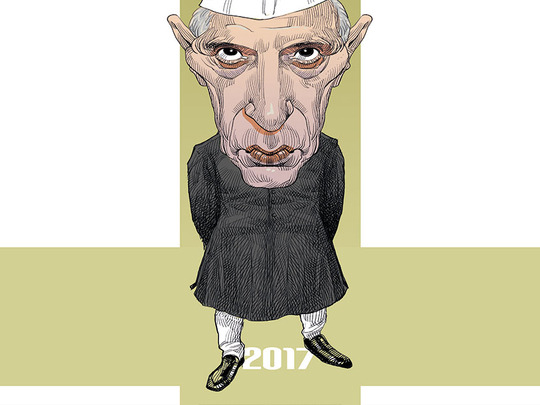
It is a sense of a nation as a cohesive whole, seen through its distinct traditions, culture and language. And crafting a national identity is a complex undertaking as the concept is difficult to grasp. It is an imaginary idea, nebulous, yet it is the very glue binding a nation together. Even in the smallest nation, citizens will never know most of their fellow-citizens, yet in the minds of each lives the imaginary idea of nationhood and all of this becomes overwhelming when it comes to India with its 1.2 billion people of differing faiths, castes and languages. India’s founding fathers knew the daunting challenges involved, but it had to be accomplished as the entire project of nation building rested on it. And Jawaharlal Nehru, the architect of modern India, deliberately set out to define this identity in syncretic terms to further this project.
Markers of identity
The most obvious markers are the national flag and the national anthem. And much before India became independent there were furious debates on the design of the national flag and in the choice of the national anthem. India also has a national song, and some of the verses of this song — Vande Matram — were deleted to make it acceptable to all. Even today this issue is controversial and debated.
Discursive essays on identity.
Aside from the voluminous writings of Mahatma Gandhi, Nehru and B.R. Ambedkar, any study of Indian-ness has to perforce include the magisterial works of Ramachandra Guha, Amartya Sen’s The Argumentative Indian, a bracing sweep through aspects of Indian history and culture, as per Sunil Khilnani, whose own seminal book Idea of India captures the paradoxes and ironies in the invention of India. Into this heady mix comes the telling quote of polymath A. K. Ramanujan, “you want self-knowledge? Come to America. Just as the Mahatma had to go jail and sit behind bars to write his autobiography. Or Nehru had go to England to discover India. Things are clear only when looked at from a distance”. Ramanujan’s essay” Is there an Indian way of thinking” written much earlier — in 1985 — than the works quoted and it was a groundbreaking enquiry that set the tone for much that was to follow.
In complete contrast to all of this is Sumathi Ramaswamy‘s The Goddess and the Nation: Mapping of Mother India. Making the case for a new kind of visual history, it charts the pictorial life and career of Bharat Mata, “Mother India,” the Indian nation imagined as mother/goddess, embodiment of national territory, and unifying symbol for the country’s diverse communities. While this, like Diane Eck’s narrative, does not directly feed into the Hindu right wing view of Indian-ness, it does provide the wherewithal’s for the identity wars that we are a witness to, today.
Evolving National Identity: A moving needle.
National identity is invented and imagined and consequently malleable and not fixed in time. Therefore it is entirely possible that in the collective consciousness of the people there can be differing and contentious views on this subject as time goes by.











